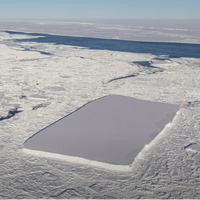Antarktika’da masa şeklinde gizemli bir buz dağı bulundu!
Ein mysteriöser tischförmiger Eisberg wurde in der Antarktis gefunden!
A mysterious table-shaped iceberg found in Antarctica!
En la Antártida se ha encontrado un misterioso iceberg con forma de mesa.
Un mystérieux iceberg en forme de table a été découvert en Antarctique !
В Антарктиде обнаружен загадочный айсберг в форме стола!
Antarktika'da masa şeklinde gizemli bir buz dağı bulundu!
A mysterious table-shaped iceberg has been found in Antarctica!
Bakın!
Nasıl olabilir böyle bir şey!
How can such a thing happen!
Neredeyse tam bir dikdörtgen.
It's almost a rectangle.
Bu fotoğrafı Twitter'da gördükten sonra neymiş acaba diye ben de araştırmaya başladım.
Fotoğraf 16 Ekim 2018'de NASA'nın düzenli olarak yaptığı IceBridge uçuşlarından birinde çekilmiş ve ertesi gün de Twitter hesabından yayımlanmış.
The photo was taken during one of NASA's regular IceBridge flights on October 16, 2018 and posted on Twitter the next day.
Tabi bu kadar düzgün bir şekli gören insanlar bir anda fotoğrafı paylaşmaya ve hakkında konuşmaya başladılar.
Of course, people who saw such a neat shape suddenly started sharing the photo and talking about it.
Buz dağı bir fenomene dönüştü.
The iceberg has become a phenomenon.
Tek bir Twitter fotoğrafından yüzlerce haber yapıldı.
Hundreds of news articles were made from a single Twitter photo.
YouTube'da onlarca video yayımlandı.
Dozens of videos have been posted on YouTube.
Şu başlıklara bir bakın.
Take a look at these titles.
Açıklanamayan gizemler!
Unexplained mysteries!
Uzaylılar olabilir mi?
Could it be aliens?
Bu size doğal görünüyor mu?
Does this look natural to you?
Hımmm emojisi… Durun daha en ilginci gelmedi, şu İspanyolca videonun başlığı: “Bunun için dev buz dağlarını kestiler.” Kimler kesti, neden kesti?
Hmm emoji... Wait, the most interesting thing is yet to come, the title of this Spanish video: "They cut down giant icebergs for this." Who cut them and why?
Arkadaş tek bir fotoğraftan yola çıkarak bütün gizemi 8 dakikalık bir videoyla nasıl çözdün ya?
How did you solve the whole mystery with an 8-minute video based on a single photo?
Gerçi benim video onunkinden daha kısa olamayacak galiba ama hem işin aslını anlatmak, hem bu safsataları çürütmek, hem de bu tür konularda nasıl bir duruş sergilemek gerektiğini göstermek imkansız olmasa da biraz zaman alıyor malesef.
Although my video may not be shorter than his, unfortunately it takes some time, although it is not impossible to tell the truth of the matter, to refute these nonsense, and to show how to take a stance on such issues.
İşin aslından başlayalım.
Let's start with the real thing.
NASA 2003'den beri uyduyla 2009'dan beri de uçaklarla sürekli olarak kutuplardaki buzlarla ilgili veri topluyor.
NASA has been continuously collecting data on polar ice since 2003 by satellite and by plane since 2009.
Bu verileri ve uçuşlar sırasında çektiği fotoğrafları da kendi web sitesinden, Twitter, Flickr gibi sosyal medya hesaplarından düzenli olarak paylaşıyor.
He regularly shares this data and the photos he took during flights on his own website and social media accounts such as Twitter and Flickr.
İşte 16 Ekim uçuşu sırasında çekilen video görüntüsü.
Here is the video footage taken during the October 16 flight.
Peki böyle bir şekil doğal olabilir mi?
But can such a shape be natural?
Doğada bu kadar keskin çizgileri, dik açıları pek fazla göremiyoruz sonuçta.
After all, we rarely see such sharp lines and right angles in nature.
Maryland Üniversitesi'nden Kelly Brunt iki çeşit buz dağı olduğunu söylüyor.
Kelly Brunt of the University of Maryland says there are two kinds of icebergs.
Bir tanesi herkesin buz dağı deyince aklına ilk gelen prizma ya da üçgen şekilli dağlar.
The first thing that comes to mind when everyone thinks of iceberg is prism or triangular shaped mountains.
Ya da yamuk yumuk diyebileceğimiz dağlar.
Or mountains that we can call crooked.
Hani şu çarpınca Titanik'i bile batıran türden.
İkinci tür buz dağlarına masa buz dağı deniyor.
Bunlar genellikle çok büyük buz kütlelerinin kenarından kopuyor.
These often break off the edge of very large ice floes.
Şimdi şu uçuş videosuna geri dönelim.
Now let's go back to that flight video.
Bizim meşhur olan dikdörtgen şekilli buz dağını geçtikten hemen sonra çok büyük bir düzlük başlıyor.
Just after passing our famous rectangular iceberg, a very large plain begins.
Bu düzlük Antaktika'nın Weddell denizinde kilometrelerce uzanan Larsen C buz kütlesi.
This plain is the Larsen C ice floe that stretches for miles in Antactic's Weddell sea.
Bu görüntüler kutuplar için akşam üstü sayılabilecek 20:30 sıralarında çekilmiş.
These images were taken around 20:30, which can be considered as late afternoon for the poles.
Biz kışa hazırlık yaparken Güney Kutbu yaza doğru gidiyor biliyorsunuz.
As we prepare for winter, the South Pole is heading towards summer, you know.
Dolayısıyla bu büyük buz kütlesinin kenarlarından erimeler, kopmalar başlıyor.
Therefore, melting and ruptures begin from the edges of this large ice mass.
Kopan parçaların arasında da bol miktarda böyle masa, sehpa, tabure şeklinde buz dağları var.
And among the broken pieces, there are plenty of icebergs in the form of tables, coffee tables, stools.
Bilim insanları bunu uzayan tırnaklara benzetiyor.
Scientists liken it to growing nails.
Tırnaklar çok uzayınca kenarlarından kırılmaya başlar ya.
When the nails get too long, they start to break from the edges.
O kırıkların da genellikle böyle düzgün şekilli olmasına benzer biçimde buz dağları da oluşabiliyor.
Icebergs can also form, similar to the fact that these fractures are usually in such a regular shape.
Sonra rüzgarlarla bu şekiller değişmeye başlıyor.
Then these shapes start to change with the winds.
Rüzgarlarla bu büyük buz kütleleri arasındaki ilişki de çok şaşırtıcı.
The relationship between the winds and these large ice floes is also very surprising.
Çünkü bu buzlar adeta “gizemli bir şarkı” söylüyorlar.
Because these ices almost sing a “mysterious song”.
Şimdi size dinleteceğim sesler, bilim insanları tarafından Antarktika'nın en büyük buz kütlesi olan Ross buz kütlesinde kaydedildi.
The sounds I'm going to listen to you now were recorded by scientists on the Ross ice floe, the largest ice block in Antarctica.
Şu seslere bir kulak verin.
Listen to these voices.
Nasıl?
“Uzaylılar bunları dikdörtgen şeklinde keserken mi çıkıyor acaba bu sesler?” diye bir video yapılabilir.
"I wonder if these sounds are made when aliens cut them into rectangles?" A video can be made.
Öylesi daha eğlenceli olurdu belki ama gerçekte rüzgarlar nedeniyle sürekli çıkıyor bu sesler.
It would be more fun that way, but in reality the winds make these noises all the time.
Ne var canım rüzgar esince bizim pencereler de şarkı söylüyor diyebilirsiniz.
What's up, my dear, you can say that our windows sing when the wind blows.
Asıl gizemi söyleyeyim mi size?
Shall I tell you the real mystery?
Tam 2 yıl boyunca bu sesleri kaydeden bilim insanları, bu seslerin bazen değiştiğini fark etmişler.
Scientists recorded these sounds for two years and noticed that they sometimes changed.
Erime nedeniyle büyük buz kütleleri birbirinden ayrılırken değiştiğini… Yani bir anlamda öyle zamanlarda bu şarkılar birer ağıta dönüşüyor.
That it changes when big ice floes are separated from each other due to melting... So in a sense, at such times, these songs turn into a lament.
Bu gizemli sesler ya da gizemli şekiller, biz onları anlayıp, anlamlandırmadıkça gizemli kalmaya devam eder.
These mysterious sounds or mysterious shapes remain mysterious until we understand and make sense of them.
Buz dağının suyun üstünde kalan kısmı diye bir tabir vardır.
There is a term called the part of the iceberg above the water.
Çünkü bu dağların görünmeyen, suyun altında kalan kısmının çok daha büyük olduğunu biliyoruz.
Because we know that the invisible, underwater part of these mountains is much bigger.
Ama göremediğimiz için bilemiyoruz.
But we don't know because we can't see it.
2012'de Güney Afrika'da Cape Town kentine gitmiştim.
In 2012, I went to Cape Town in South Africa.
Uçak alçalırken oranın en meşhur dağının bir fotoğrafını çektim.
As the plane descended, I took a photo of the most famous mountain there.
Gerçi bulutlardan dolayı neden meşhur olduğu burada tam anlaşılmıyor.
Although it is not fully understood here why it is famous because of the clouds.
O zaman size bir de şunu göstereyim.
Then let me show you this.
Bu da zirveye yakın bir noktadan çektiğim bir diğer görüntü.
This is another image I took from a point near the summit.
Evet bu meşhur dağın adı gerçekten de “Masa Dağı.” Ve eğer bu dağın da %80'i suyun altında olsaydı muhtemelen üzerindeki 3 km uzunluğundaki düzlüğü bizim meşhur buz dağına benzetip çok şaşıracaktık.
Yes, the name of this famous mountain is indeed “Table Mountain.” And if 80% of this mountain were under water, we would probably be surprised by comparing the 3 km-long plain on it to our famous iceberg.
Venezuela'daki Roraima ve Kukenan Dağları, Kovboy filmlerinden de alışık olduğumuz Utah'taki Kanyonlar, Etiyopya'daki Debre Damo, Avustralya'daki Conner Dağı gibi dik açılı doğal dağları kutupların dışında da görebiliyoruz.
We can also see steep-angled natural mountains outside the poles, such as the Roraima and Kukenan Mountains in Venezuela, the Canyons in Utah, which we are accustomed to from cowboy movies, Debre Damo in Ethiopia, and Mount Conner in Australia.
Daha küçük ölçeğe indiğimizde 168 çeşit kübik mineral olduğunu biliyoruz ki bunlardan bir tanesi belki evinizde de bulabileceğiniz kaya tuzu.
On a smaller scale, we know that there are 168 kinds of cubic minerals, one of which is rock salt, which you may find in your home.
Yani doğada şaşırtıcı bir şeyler görmek için o kadar uzaklara gitmeye gerek yok.
So you don't have to go that far to see something amazing in nature.
Yeter ki görmek isteyelim.
As long as we want to see it.
Yeter ki sosyal medyadaki bir fotoğrafa bakmakla kalmayıp bunu içimizdeki bilim ve araştırma aşkını tetikleyecek bir kıvılcım olarak değerlendirelim.
Let's not just look at a photo on social media, but consider it as a spark that will trigger our love of science and research.
Böyle bir bakış açısı kazanırsak o fotoğrafın yayımlandığı Twitter hesabında her gün birbirinden güzel başka fotoğrafların da olduğunu fark ederiz.
If we gain such a point of view, we realize that there are other beautiful photos every day on the Twitter account where that photo is published.
Mesela üçgen şeklinde buz dağı olduğunu da.
For example, that there is a triangular iceberg.
Biraz daha araştırırsak bunların şeklinden çok neden büyük buz kütlelerinden koptuğunu düşünmeye başlarız.
If we investigate a little more, we begin to think about why they break from large ice floes rather than their shape.
Çünkü karşımıza şu çarpıcı gerçek çıkar.
Because we have this striking truth.
40 yıldan beri uyduyla takip edilen Kuzey Kutup Denizi'ndeki buzlar 23 Eylül 2018'de daha 1 ay önce 6. kez en düşük seviyeye ulaştı.
The ice in the Arctic Sea, which has been tracked by satellite for 40 years, reached its lowest level for the 6th time, just one month ago, on September 23, 2018.
İşte eğer bu duruşu, bu bakış açısını kazanamazsak gördüğümüz her dikdörtgen bizi sadece şaşırtır.
If we do not gain this stance, this point of view, every rectangle we see will only surprise us.
Şaşkınlığımızla kalakalırız.
We are left in amazement.
Kimilerimiz korkar, kimilerimiz konuyu uzaylılara bağlar.
Some of us are afraid, some of us connect the subject to aliens.
Anlamaya çalışmazsak insanlığımız hep bu seviyede kalmaya devam eder.
If we don't try to understand, our humanity will always remain at this level.

